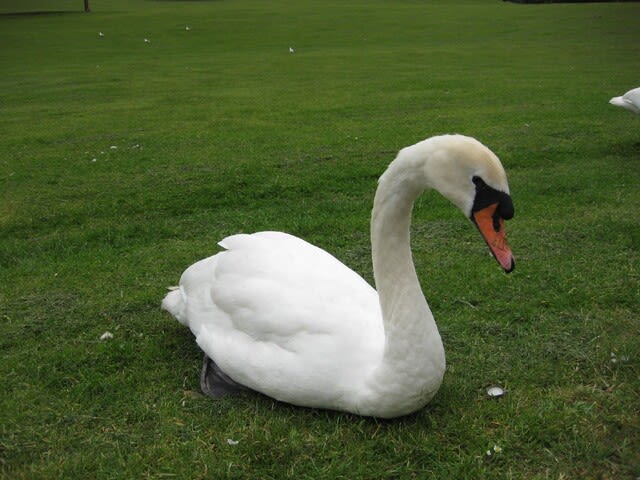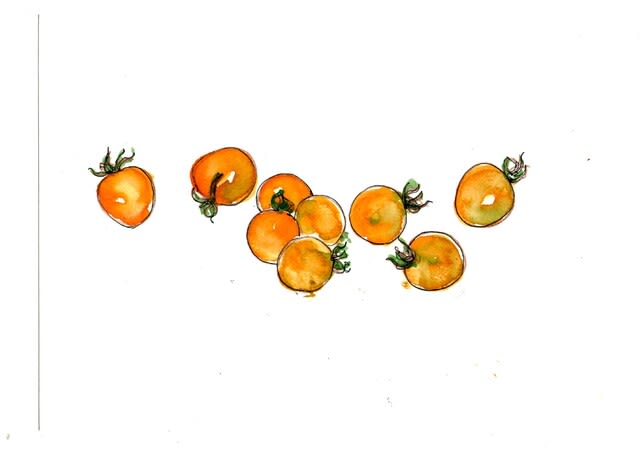
今日の「 お気に入り 」は 、ノンフィクション作家 ビル・ブライソンさん の
著書 " The Body ― A Guide for Occupants " からの 抜き書き 。
" ・・・ Unpacked, you are positively enormous. Your lungs, smoothed out,
would cover a tennis court, and the airways within them would stretch nearly
from coast to coast. The length of all your blood vessels would take you two
and a half times around Earth. The most remarkable part of all is your DNA
( or deoxyribonucleic acid ). You have a meter of it packed into every cell, and
so many cells that if you formed all the DNA in your body into a single strand,
it would stretch ten billion miles, to beyond Pluto. Think of it : there is enough
of you to leave the solar system. You are in the most literal sense cosmic.
But your atoms are just building blocks and are not themselves alive. Where
life begins precisely is not so easy to say. The basic unit of life is the cell ー
everyone is agreed on that. The cell is full of busy things ― ribosomes and
proteins, DNA, RNA, mitochondria, and much other cellular arcana ― but
none of those are themselves alive. The cell itself is just a compartment ― a
kind of little room : a cell ― to contain them, and of itself is as nonliving as
other room. Yet somehow when all of these things are brought together, you
have life. That is the part that eludes science. I kind of hope it always will.
What is perhaps most remarkable is that nothing in charge. Each component
of the cell responds to signals from other components, all of them bumping and
jostling like so many bumper cars, yet somehow all this random motion results
in smooth, coordinated action, not just across the cell but across the whole
body as cells communicate with other cells in different parts of your personal
cosmos.
The heart of the cell is the nucleus. It contains the cell's DNA ― three feet
of it, as we have already noted, scrunched into a space that we may reasonably
call infinitesimal. The reason so much DNA can fit into a cell nucleus is that it is
exquisitely thin. You would need twenty billion strands of DNA laid side by side
to make the width of the finest human hair. Every cell in your body ( strictly
speaking, every cell with a nucleus ) holds two copies of your DNA. That's why
you have enough to stretch to Pluto and beyond.
DNA exists for just one purpose ― to create more DNA. A DNA molecule, as
you will almost certainly remember from countless television programs if not
school biology, is made up of two strands, connected by rungs to form the
celebrated twisted ladder known as a double helix. Your DNA is simply an
instruction manual for making you. A length of DNA is divided into segments
called chromosomes and shorter individual units called genes. The sum of
all your genes is the genome.
DNA is extremely stable. It can last for tens of thousands of years. "
" DNA passes on information with extraordinary fidelity. It makes only about
one error per every billion letters copied. Still, because your cells divide so
much, that is about three errors, or mutations, per cell division. Most of those
mutations the body can ignore, but just occasionally they have lasting
significance. That is evolution.
All of the components of the genome have one single-minded purpose ― to
keep the line of your existence going. "
" Maintaining equilibrium within the body is called homeostasis. The man who coined
the term and is often referred to as the father of the discipline was the Harvard
physiologist Walter Bradford Cannon ( 1871 - 1945 ). "
" ・・・ One thing Cannon didn't understand ― no one did yet ― was what a
staggering amount of energy the body requires at the cellular level in order to
maintain itself. It took a very long time to figure that out, and when the answer
came, it was provided not by some mighty research institute but by an eccentric
Englishman working pretty much on his own in a pleasant country house in the
west of England.
We now know that inside and outside the cell are charged particles called ions.
Between them in the cell membrane is a kind of tiny air lock known as an ion
channel. When the air lock is opened, the ions flow through, and that generates
a little buzz of electricity ― though " little " here is entirely a matter of perspective.
Although each electrical twitch at the cellular level produces just one hundred
millivolts of energy, that translates as thirty million volts per meter ― about the
same as in a bolt of lightning. Put another way, the amount of electricity going
on within your cells is a thousand times greater than the electricity within your
house. You are, in a very small way, exceedingly energetic.
It's all a matter of scale. Imagine, for purposes of demonstration, firing a bullet
into my abdomen. It really hurts and it does a lot of damage. Now imagine firing
the same bullet into a giant fifty miles tall. It doesn't even penetrate his skin. It's
the same bullet and gun, just a different scale. That's more or less the situation
with the electricity in your cells.
The stuff responsible for the energy in our cells is a chemical called adenosine
triphosphate, or ATP, which may be the most important thing in your body you
have never heard of. Every molecule of ATP is like a tiny battery in that it stores
up energy and then releases it to power all the activities required by your cells
― and indeed by all cells, in plants as well as animals. The chemistry involved
is magnificently complex. Here is one sentence from a chemistry textbook
explaining a little what it does : " Being polyanionic and featuring a potentially
chelatable polyphosphate group, ATP binds metal cations with high affinity. "
For our purposes here it is enough to know that we are powerfully dependent
on ATP to keep our cells humming. Every day you produce and consume your
own body weight in ATP ― some 200 trillion trillion molecules of it. From ATP's
point of view, you are really just a machine for producing ATP. Everything else
about you is by-product. Because ATP is consumed more or less instantaneously,
you have only sixty grams ― that is a little over two ounces ― of it within you at
any given moment.
It took a long time to figure any of this out, and when it came, almost no one at
first believed it. The person who discovered the answer was a retiring, self-funded
scientist named Peter Mitchell who in the early 1960s inherited a fortune from
the Wimpey house-building company and used it to set up a research center in
a stately home in Cornwall. "
" Mitchell's ideas were universally dismissed, not altogether surprisingly. As one
chronicler has noted, " At the time that Mitchell proposed his hypothesis there
was not a shred of evidence in support of it. " But he was eventually vindicated
and in 1978 was awarded the Nobel Prize in Chemistry ― an extraordinary
accomplishment for someone who worked from a home lab. "
( 出典 :Bill Bryson 著 " The Body ― A Guide for Occupants " .
Knopf Doubleday Publishing Group. 刊 )
上掲の英語の文章は 、翻訳本の中で 、次のように 日本語訳されています 。
「 ・・・ 中身を広げると 、ヒトは実はとても巨大だ 。肺を平らに伸ばせばテニス
コート一面を覆えるし 、肺の中の気道はロンドンからモスクワにまで届く 。すべ
ての血管をつなげば 、その長さは地球二周半にもなる 。何より注目すべき部分は 、
DNA ( デオキシリボ核酸 ) だ 。ほぼすべての細胞に1メートルのDNAが詰め込ま
れているうえに 、あまりにもたくさんの細胞があるので 、もし体内のあらゆる
DNA で1本の細いひもをつくったとすれば 、それは150億キロメートル 、冥
王星のずっと先まで達するだろう 。考えてみてほしい 。自分の中に 、太陽系を
超えていくほどのものがある 。あなたはまさに文字どおりの意味で 、宇宙規模
の存在なのだ 。
しかし 、人体の原子たちはただの構成要素であって 、それ自体は生きていない 。
生命が具体的に何をもって始まるのかを判断するのはなかなかむずかしい 。生命
の基本単位は細胞だ 。それについては誰もが同意している 。細胞は忙しい物質た
ちでいっぱいだ — リボソーム 、タンパク質 、DNA 、RNA 、ミトコンドリア 、そ
の他たくさんの微細で謎めいた物質 — が 、どれもそれ自体は " 生きている " とは
いえない 。細胞そのものは 、ただの区画だ 。セル 、つまり一種の小部屋として
その物質たちを収め 、どの部屋もそれ自体では生きていない 。しかしどういうわ
けか 、こういう物質すべてをひとつに集めると 、生命が生まれる 。それは 、科
学では説明のつかない部分だ 。なんとなく 、いつまでも謎のままであってほしい
ような気もする 。
おそらく最も注目すべき点は 、指揮者がいないことだ 。細胞の各成分は他の成
分からの信号に反応し 、すべてが遊園地のゴーカートのようにぶつかったり押し
合ったりしているが 、それでもなぜかあらゆる無作為な動きが 、細胞内だけでな
く全身で円滑な協調行動になる 。細胞は 、ヒトの内なる宇宙のさまざまな部分に
ある他の細胞と連絡を取り合っている 。
細胞の中心となるのが核だ 。そこには細胞のDNAがある 。先ほど触れたように 、
1メートルの長さがあり 、極小と呼ぶにふさわしい空間に詰め込まれている 。そ
んなに長いDNAが細胞核の中に収まるのは 、みごとなほど薄いからだ 。最も細い
人毛と同じ幅にするには 、DNA鎖を二百億本並べる必要がある 。体のあらゆる細
胞 ( 厳密にいえば 、核をもつあらゆる細胞 ) に 、DNAがふた組ずつ入っている 。
だから 、冥王星の先まで伸ばせるだけの長さがあるのだ 。
DNAは 、ただひとつの目的のために存在する 。つまり 、さらに多くのDNAを
つくること 。ヒトのDNAは 、ヒトをつくるための " マニュアル " だ 。生物の授業
はともかく 、きっと数え切れないほどのテレビ番組で見て憶えていると思うが 、
DNA分子は二本のひもから成り 、横木でつながれて 、二重らせんと呼ばれるあの
有名なねじれたはしごの形をしている 。ひと組のDNAは染色体という複数の部位
に分けられ 、その中にさらに短い遺伝子と呼ばれる個々の単位がある 。ひと組の
DNAの遺伝情報をすべて合わせたものがゲノムだ 。
DNAは 、きわめて安定している 。何万年も存続できるほどだ 。」
「 DNAは 、並外れた精確さで情報を伝達する 。十億文字につき約一文字しか 、
コピーを間違えない 。それでも 、細胞分裂一回につき約三つのエラー 、つまり
『 突然変異 』が起こることになる 。突然変異のほとんどは体にとって無視でき
るものだが 、ほんのときたま 、持続的な影響を残す 。それが『 進化 』だ 。
ゲノムのあらゆる成分は 、ただひとつの目的を持っている 。あなたの存在を保
ち続けることだ 。」
「 体内の平衡を保つ働きのことをホメオスタシス ( 恒常性 ) と呼ぶ 。この言葉を
つくり 、 " 秩序の父 " と言われることも多いのが 、ハーヴァード大学の生理学
者ウォルター・ブラッドフォード・キャノン ( 1871 - 1945 ) だ 。」
「 ・・・ ひとつ 、キャノンが 気づいていなかった ― 誰もまだ気づいていなか
った ― ことは 、自らを維持するために 、体が細胞レベルでどれほど膨大な量
のエネルギーを必要とするかだった 。それを突き止めるにはとても長い時間が
かかり 、しかも答えを出したのはどこかの有力な研究機関ではなく 、イギリス
西部の快適な田舎屋敷を拠点にほぼひとりで研究していた風変わりなイギリス
人だった 。
現在では 、細胞の内外にイオンと呼ばれる電荷を帯びた粒子があることがわ
かっている 。細胞膜には 、イオンチャンネルと呼ばれる小さなエアロックのよ
うなものがある 。エアロックがあくと 、イオンがそこを通り抜けることで 、
小さな電気が発生する 。ただし 、ここでの " 小さな " は完全に見かたの問題だ 。
細胞レベルでのひとつひとつの電気のひらめきは 、ほんの百ミリボルトのエネ
ルギーしか生まないが 、一メートル当たりでは三千万ボルトに換算される ― 稲
妻と同じくらいだ 。別の言いかたをするなら 、細胞内で生じている電気量は 、
あなたの家の電気より千倍大きい 。あなたは 、とてもささやかな規模で 、もの
すごく活気に満ちているのだ 。
すべては規模の問題といえる 。実演のために 、わたしの腹部に銃弾を撃ち込
んだと想像してみてほしい 。すごく痛いし 、たいへんなダメージを負うことに
なる 。では 、同じ弾丸を身長八十キロメートルの巨人に撃ち込んだと想像し
てみてほしい 。皮膚を貫通することさえないだろう 。同じ弾丸と銃だが 、規
模だけが違う 。細胞内の電気をめぐる状況も 、それと似たようなものだ 。
細胞でエネルギーを生み出しているのは 、アデノシン三リン酸 ( ATP ) と呼
ばれる化学物質で 、もしかするとあなたが聞いたこともない体内の物質の中で 、
最も重要かもしれない 。ATPのあらゆる分子は小さな電池のようなもので 、
エネルギーを蓄えてから 、ヒトの細胞 — それどころか動物も植物も含めた
あらゆる細胞 — が必要とするすべての活動に動力を供給するため 、エネル
ギーを放出する 。そこに関わっている 化学反応は恐ろしく複雑だ 。 そこで
何が行なわれているかを少し説明した化学の教科書を一行だけ引用しよう 。
『 ATP は 、多価陰イオンであり 、キレート化可能なポリリン酸基を特徴と
し 、高親和性で金属陽イオンと結合する 』。ここでは 、わたしたちが細胞
を活発に動かし続けるため 、大いにATPに頼っていることがわかればじゅう
ぶんだろう 。毎日 、ヒトは自分の体重と同じ量のATPをつくり 、利用して
いる 。およそ二百杼 ( じょ ) [ 訳注 十の二十四乗 ] 個の分子だ 。ATPから見
れば 、あなたはATPをつくるための単なる機械だ 。ほかの部分はすべて 、
副産物にすぎない 。ATPはほとんど即座に消費されるので 、いつでも体内
にはほんの六十グラムしか存在しない 。
長い時間をかけてこういう事実が判明しても 、最初はほとんど誰も信じなかった 。
答えを見つけた人物は 、自己資金で研究していた風変わりな科学者 、ピー
ター・ミッチェルだった 。1960年代初めに 、住宅建設会社ウィンピー
の所有者である叔父から財産を相続し 、それを使ってコーンウォールにある
大邸宅に研究センターを設置した 。」
「 それほど意外でもないが 、ミッチェルの考えは一様に退けられた 。ある年
代記作家はこう記した 。『 ミッチェルが仮説を提示した時点では、それを
支持する一片の証拠もなかった 』。しかし 、やがてその説の正しさが証明
され 、ミッチェルは1978年にノーベル化学賞 を受賞した 。自宅の実験
室で研究した者としては 、並外れた業績だ 。」
( 出典 : ビル・ブライソン著 桐谷知未訳 「 人体大全 ― なぜ生まれ 、
死ぬその日まで無意識に動き続けられるのか ― 」新潮社 刊 )
原書および翻訳本からの引用はここまで 。
「 無限小 」 と「 無限大 」、
ヒトの内なる「 小宇宙 」と周りの「 大宇宙 」 、凡人の理解及ばぬ 、
時空を超えた「 からくり 」、知りたくもあり 、知りたくもなし。
インターネットのフリー百科事典「 ウィキペディア 」には 、文中に出てくるATPに
ついて 、次のような用語解説記事が掲載されています 。
選択科目「 化学 」で受験した56年前を思い出すも 、リボースって何? 、ヌクレオチドって何? 、
・・・ 調べりゃわかることだけど 。
「 アデノシン三リン酸( アデノシンさんリンさん 、adenosine triphosphate)とは 、
アデノシンのリボースに3分子のリン酸が付き 、2個の高エネルギーリン酸結合を
持つヌクレオチドである 。リボースの5位の炭素に、リン酸が結合しているため 、
アデノシン5'-三リン酸などとも書かれる 。しばしば『 adenosine triphosphate 』
の下線部のアルファベットを並べて『 ATP( エー・ティー・ピー )』と呼称される。」
「 ATPは真核生物や真正細菌など 、既知の地球生物の全ての細胞が利用している解糖
系でも産生される物質であるため 、地球上の生物の体内に広く分布する 。生体内
では、リン酸1分子、または、リン酸2分子が離れたり結合したりする事で、
エネルギーの放出・貯蔵を行 う。なお例えば 、糖に限らず、真核生物が脂肪酸や
アミノ酸などをエネルギーとして利用する際も 、例えば、一部はGTPに変換されて 、
そのままGTPが別の用途に用いられる場合など例外はあるものの 、主にATPに変換
してからエネルギーとして利用し 、色々な用途に活用している 。
これらの理由ため 、既知の地球生物の各細胞には普遍的にATPが存在する 。」
「 なお 、しばしば地球生物の細胞は 、ATPを経由して物質のエネルギーを利用して
いるため 、ATPは「 生体のエネルギー通貨 」とも形容される 。」
「 1978年 - 化学浸透圧説を唱えたMitchellがノーベル化学賞を受賞した 。」































